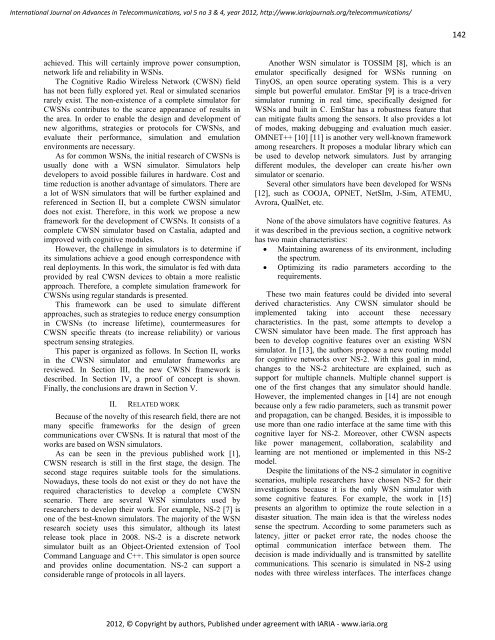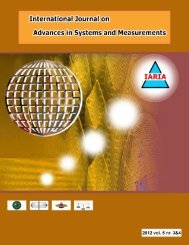download vol 5, no 3&4, year 2012 - IARIA Journals
download vol 5, no 3&4, year 2012 - IARIA Journals
download vol 5, no 3&4, year 2012 - IARIA Journals
You also want an ePaper? Increase the reach of your titles
YUMPU automatically turns print PDFs into web optimized ePapers that Google loves.
International Journal on Advances in Telecommunications, <strong>vol</strong> 5 <strong>no</strong> 3 & 4, <strong>year</strong> <strong>2012</strong>, http://www.iariajournals.org/telecommunications/<br />
achieved. This will certainly improve power consumption,<br />
network life and reliability in WSNs.<br />
The Cognitive Radio Wireless Network (CWSN) field<br />
has <strong>no</strong>t been fully explored yet. Real or simulated scenarios<br />
rarely exist. The <strong>no</strong>n-existence of a complete simulator for<br />
CWSNs contributes to the scarce appearance of results in<br />
the area. In order to enable the design and development of<br />
new algorithms, strategies or protocols for CWSNs, and<br />
evaluate their performance, simulation and emulation<br />
environments are necessary.<br />
As for common WSNs, the initial research of CWSNs is<br />
usually done with a WSN simulator. Simulators help<br />
developers to avoid possible failures in hardware. Cost and<br />
time reduction is a<strong>no</strong>ther advantage of simulators. There are<br />
a lot of WSN simulators that will be further explained and<br />
referenced in Section II, but a complete CWSN simulator<br />
does <strong>no</strong>t exist. Therefore, in this work we propose a new<br />
framework for the development of CWSNs. It consists of a<br />
complete CWSN simulator based on Castalia, adapted and<br />
improved with cognitive modules.<br />
However, the challenge in simulators is to determine if<br />
its simulations achieve a good e<strong>no</strong>ugh correspondence with<br />
real deployments. In this work, the simulator is fed with data<br />
provided by real CWSN devices to obtain a more realistic<br />
approach. Therefore, a complete simulation framework for<br />
CWSNs using regular standards is presented.<br />
This framework can be used to simulate different<br />
approaches, such as strategies to reduce energy consumption<br />
in CWSNs (to increase lifetime), countermeasures for<br />
CWSN specific threats (to increase reliability) or various<br />
spectrum sensing strategies.<br />
This paper is organized as follows. In Section II, works<br />
in the CWSN simulator and emulator frameworks are<br />
reviewed. In Section III, the new CWSN framework is<br />
described. In Section IV, a proof of concept is shown.<br />
Finally, the conclusions are drawn in Section V.<br />
II. RELATED WORK<br />
Because of the <strong>no</strong>velty of this research field, there are <strong>no</strong>t<br />
many specific frameworks for the design of green<br />
communications over CWSNs. It is natural that most of the<br />
works are based on WSN simulators.<br />
As can be seen in the previous published work [1],<br />
CWSN research is still in the first stage, the design. The<br />
second stage requires suitable tools for the simulations.<br />
Nowadays, these tools do <strong>no</strong>t exist or they do <strong>no</strong>t have the<br />
required characteristics to develop a complete CWSN<br />
scenario. There are several WSN simulators used by<br />
researchers to develop their work. For example, NS-2 [7] is<br />
one of the best-k<strong>no</strong>wn simulators. The majority of the WSN<br />
research society uses this simulator, although its latest<br />
release took place in 2008. NS-2 is a discrete network<br />
simulator built as an Object-Oriented extension of Tool<br />
Command Language and C++. This simulator is open source<br />
and provides online documentation. NS-2 can support a<br />
considerable range of protocols in all layers.<br />
A<strong>no</strong>ther WSN simulator is TOSSIM [8], which is an<br />
emulator specifically designed for WSNs running on<br />
TinyOS, an open source operating system. This is a very<br />
simple but powerful emulator. EmStar [9] is a trace-driven<br />
simulator running in real time, specifically designed for<br />
WSNs and built in C. EmStar has a robustness feature that<br />
can mitigate faults among the sensors. It also provides a lot<br />
of modes, making debugging and evaluation much easier.<br />
OMNET++ [10] [11] is a<strong>no</strong>ther very well-k<strong>no</strong>wn framework<br />
among researchers. It proposes a modular library which can<br />
be used to develop network simulators. Just by arranging<br />
different modules, the developer can create his/her own<br />
simulator or scenario.<br />
Several other simulators have been developed for WSNs<br />
[12], such as COOJA, OPNET, NetSIm, J-Sim, ATEMU,<br />
Avrora, QualNet, etc.<br />
None of the above simulators have cognitive features. As<br />
it was described in the previous section, a cognitive network<br />
has two main characteristics:<br />
• Maintaining awareness of its environment, including<br />
the spectrum.<br />
• Optimizing its radio parameters according to the<br />
requirements.<br />
These two main features could be divided into several<br />
derived characteristics. Any CWSN simulator should be<br />
implemented taking into account these necessary<br />
characteristics. In the past, some attempts to develop a<br />
CWSN simulator have been made. The first approach has<br />
been to develop cognitive features over an existing WSN<br />
simulator. In [13], the authors propose a new routing model<br />
for cognitive networks over NS-2. With this goal in mind,<br />
changes to the NS-2 architecture are explained, such as<br />
support for multiple channels. Multiple channel support is<br />
one of the first changes that any simulator should handle.<br />
However, the implemented changes in [14] are <strong>no</strong>t e<strong>no</strong>ugh<br />
because only a few radio parameters, such as transmit power<br />
and propagation, can be changed. Besides, it is impossible to<br />
use more than one radio interface at the same time with this<br />
cognitive layer for NS-2. Moreover, other CWSN aspects<br />
like power management, collaboration, scalability and<br />
learning are <strong>no</strong>t mentioned or implemented in this NS-2<br />
model.<br />
Despite the limitations of the NS-2 simulator in cognitive<br />
scenarios, multiple researchers have chosen NS-2 for their<br />
investigations because it is the only WSN simulator with<br />
some cognitive features. For example, the work in [15]<br />
presents an algorithm to optimize the route selection in a<br />
disaster situation. The main idea is that the wireless <strong>no</strong>des<br />
sense the spectrum. According to some parameters such as<br />
latency, jitter or packet error rate, the <strong>no</strong>des choose the<br />
optimal communication interface between them. The<br />
decision is made individually and is transmitted by satellite<br />
communications. This scenario is simulated in NS-2 using<br />
<strong>no</strong>des with three wireless interfaces. The interfaces change<br />
<strong>2012</strong>, © Copyright by authors, Published under agreement with <strong>IARIA</strong> - www.iaria.org<br />
142







